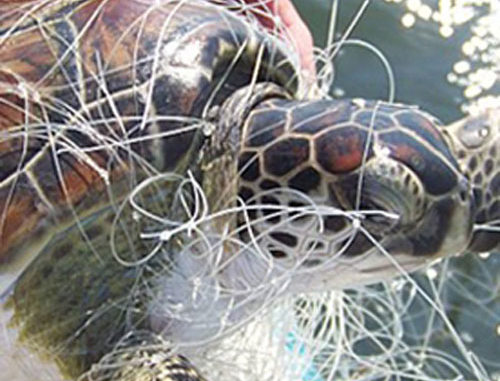
Marine fisheries’ hand forced by too many turtles in nets
The N.C. Marine Fisheries Commission voted at its May meeting in Atlantic Beach to close the lower Core Sound, Back Sound and the North River to all large-mess gill nets and to restrict the amount of nets that can be fished in an area from Lennoxville Point near Beaufort to the US 58 bridge between Emerald Isle and Cape Carteret.
The votes came on the heels of the National Marine Fisheries Service informing the N.C. Division of Marine Fisheries that the state needed to lower the number of “interactions” between gill nets and endangered sea turtles. Closure of several areas and restrictions in other areas were determined by a 6-3 vote to be the best course of action. The three dissenting votes were cast by commercial members of the Commission, fish-house owners Mikey Daniels, Joe Smith and Bradley Styron.
Large-mesh gill nets are those with a mesh measuring 4 inches or greater.
At issue for the Commission was the fact that the NMFS did not believe that an Incidental Take Permit application filed by NCDMF would reduce interactions between netters and sea turtles to an acceptable level.
The Core Sound-Back Sound-North River area is known as the “D-1” area, and the area between Beaufort and the US 58 bridge is known as the “D-2” area. In that area, fishermen will be limited to 1,000 yards of gill nets instead of 2,000 yards.
“We did all the reports and applied for the state-wide ITP roughly a year ago,” said Dr. Louis Daniel, director of NCDMF. “The original ITP for the (Pamlico Sound area) expired in December 2010, and we were granted an extension through 2011 to be allowed to fish until the new ITP was issued. We thought it was forthcoming, but we were contacted (on May 3) and told we needed to lower the number of potential interactions. The request from NMFS was to rewrite the entire ITP and re-submit it. We had to find a way to reduce the interactions. Our staff is working diligently … but it is a daunting task.
“We had to do something to be proactive in reducing the sea turtle interactions and trying to get a new ITP issued. No one likes it for the fishermen in the D-1 area, but this area accounts for 53 percent of our sea turtle interactions each year. One of the things NMFS mentioned was to reduce incidents in the hot spots, and this definitely was a hot spot. At least there are some spots close by these fishermen can go to fish.”
The NCDMF and Commission have been walking a tightrope through a gill-net minefield for the past several years, since several species of sea turtles were added to the list of endangered species, while several others were listed as threatened – meaning they aren’t supposed to be bother in any way by fishermen, commercial or recreational. The difficult part for NCDMF has been that sea turtles and several species of commercially important fish live in the same habitat, and that makes for occasional interactions between turtles and gill nets.
NCDMF first banged heads with NMFS in the Pamlico Sound, which was closed because sea turtles were being trapped in gill nets and drowning. After research and changes in the equipment allowed and times nets could be used, the NMFS issued an ITP, which allowed them a specific number of annual interactions with turtles; if the number was reached, the gill-net fishery would close immediately.
Then, the Karen Beasley Sea Turtle Rescue and Recovery Center in Topsail Beach filed suit against the Commission and NCDMF charging that gill-net fishermen were still killing and injuring too many sea turtles. NCDMF settled the suit by changing time and gear limitations again, but the agreement required NCDMF to acquire a statewide ITP.
The NCDMF had been operating under the ITP proposed in its permit application, but it was that application that NMFS rejected.
Daniel said that if NCDMF doesn’t receive a statewide ITP or an extention of the Pamlico Sound ITP, gill-netting in the Pamlico Sound area will not reopen. He said receiving a new ITP is critical, because NMFS could decide to close gill-net fishing statewide at any time.


Be the first to comment